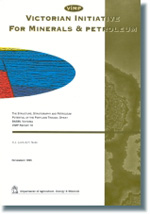VIMP Report 18 - The Structure, Stratigraphy and Petroleum Potential of the Portland Trough, Otway Basin, Victoria
 |
| |||||
Product description:Download The downloadable version of this report is supplied in PDF format. Executive Summary The Portland Trough is an extensive Tertiary depression in far southwestern Victoria delineated via seismic and borehole mapping. This trough is noted to obliquely overprint the thickened Late Cretaceous Voluta Trough within the study area. This study examines the Portland Trough, the underlying Voluta Trough and their marginal terrains. The authors have also developed a tectonic model different to existing models. The authors suggest that the Sherbrook Group represents a syn-rift sequence in the Otway Basin which was marine dominated in a region where crustal attenuation had already occurred during the Early Cretaceous. Features consistent with a syn-rift Sherbrook Group include the presence of large, low angle extensional faults and the lack of any shelf break. This allows a model for the development of the Eumeralla Formation as a post-rift sequence in the western Otway Basin developed over Crayfish syn-rift sediments. The base Tertiary unconformity then becomes the breakup unconformity in the Otway Basin. The Wangerrip Group is an early post-rift sequence. It is thick in the Portland Trough, developed as a delta situated in a region that is likely to have been a Late Cretaceous accommodation zone. Localised extension on structures such as the Wanwin and Tartwaup Faults is consistent with growth faulting as a consequence of significant sediment loading. Prospective leads were noted at both the base Tertiary level and at the base Sherbrook level. Leads at base Tertiary level are associated with Maastrichtian inversion features and rollover associated with normal faults reactivated as a consequence of sediment loading. Several large highs are noted along the Cape Bridgewater High and another similarly trending high to the south. These leads are probably the largest at the base Tertiary level in the entire Otway Basin. Several large tilted fault block leads at the early Sherbrook Group level are available to both onshore and offshore explorers in the region, with good reservoir and seal lithologies noted at the base Sherbrook level. The study area is a region where seismic coverage is reasonable but well control is poor. Modern explorers have to contend with variable seismic quality, although much of the seismic data has recently been reprocessed. With the acquisition of new lines, the study area is becoming an increasingly attractive region to explore. The last frontier of exploration in the study area is the coastal region near Portland which requires infill seismic data. This area is emerging as a very prospective region. Bibliographic reference Lavin, C.J. & Naim, H., 1995. The structure, stratigraphy and petroleum potential of the Portland Trough, Otway Basin, Victoria. Victorian Initiative for Minerals and Petroleum Report 18. Department of Agriculture, Energy and Minerals. | ||||||

